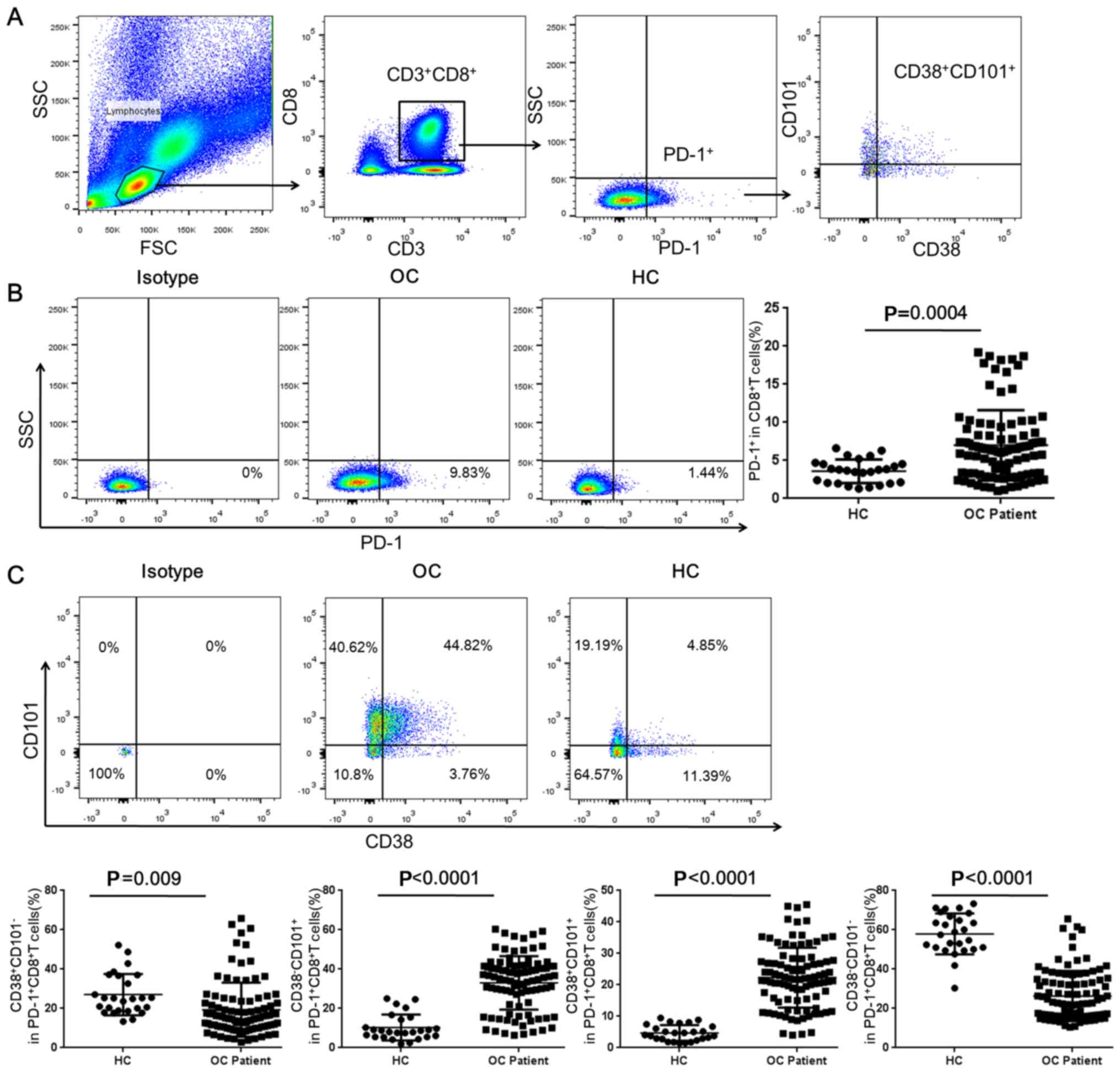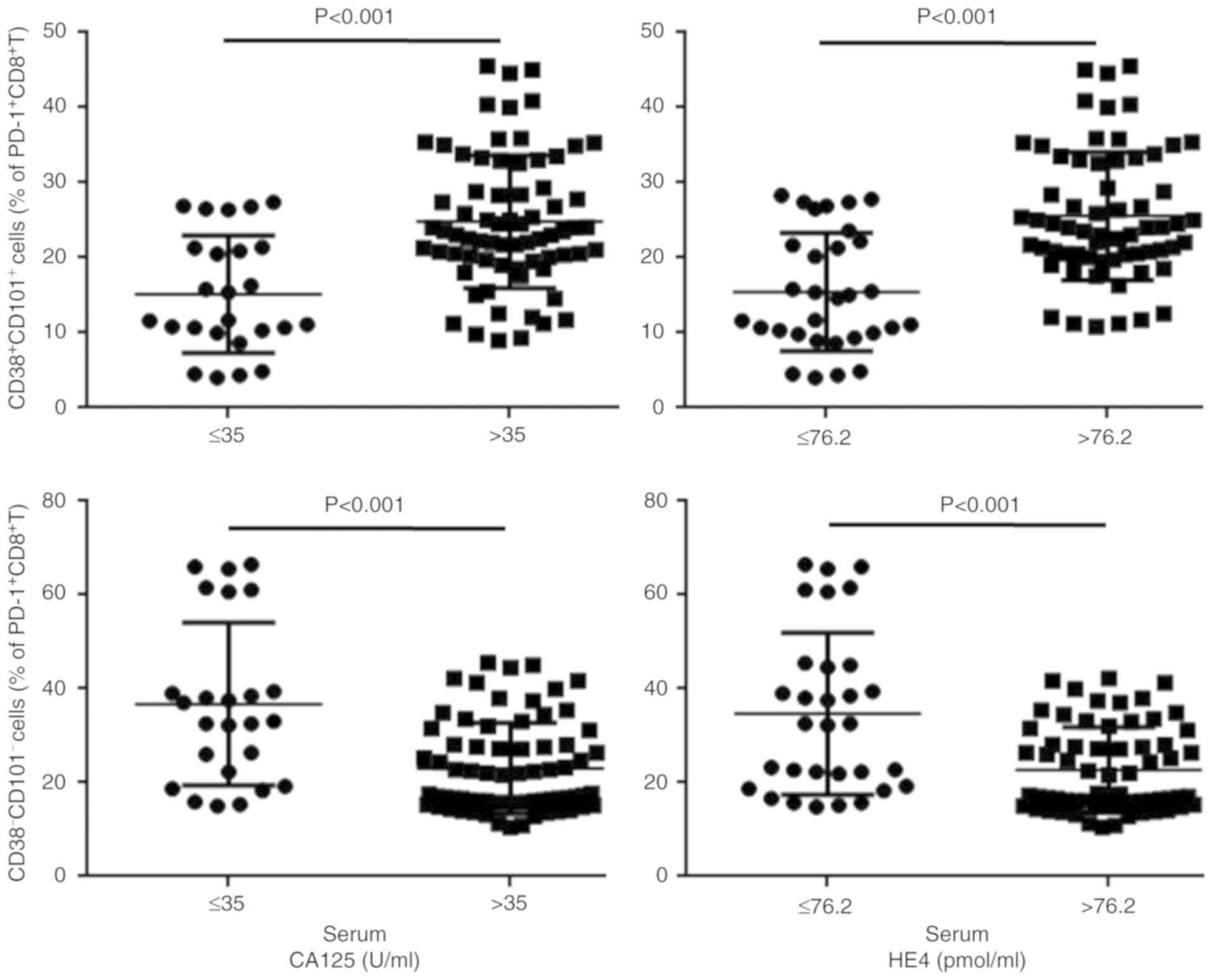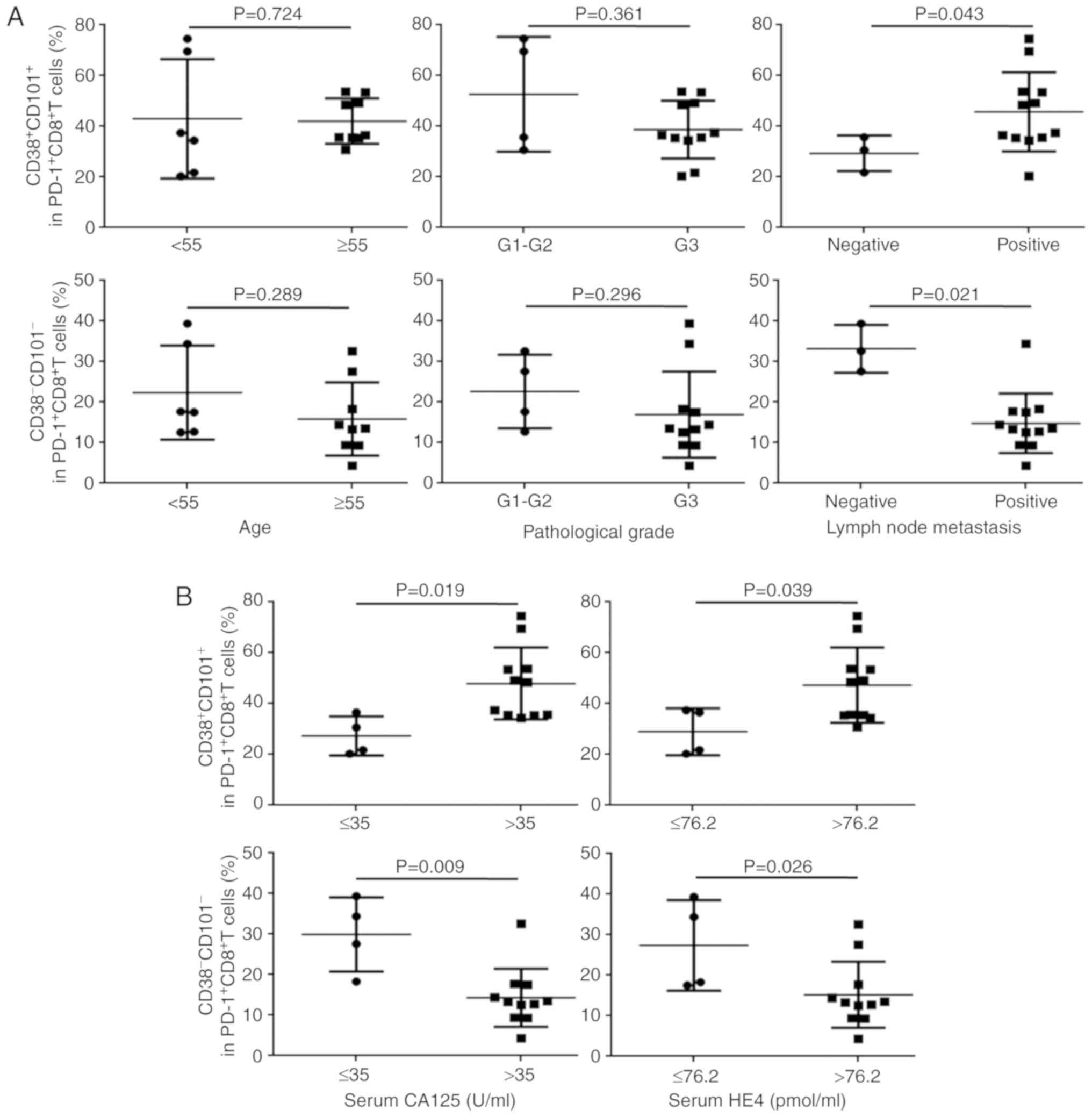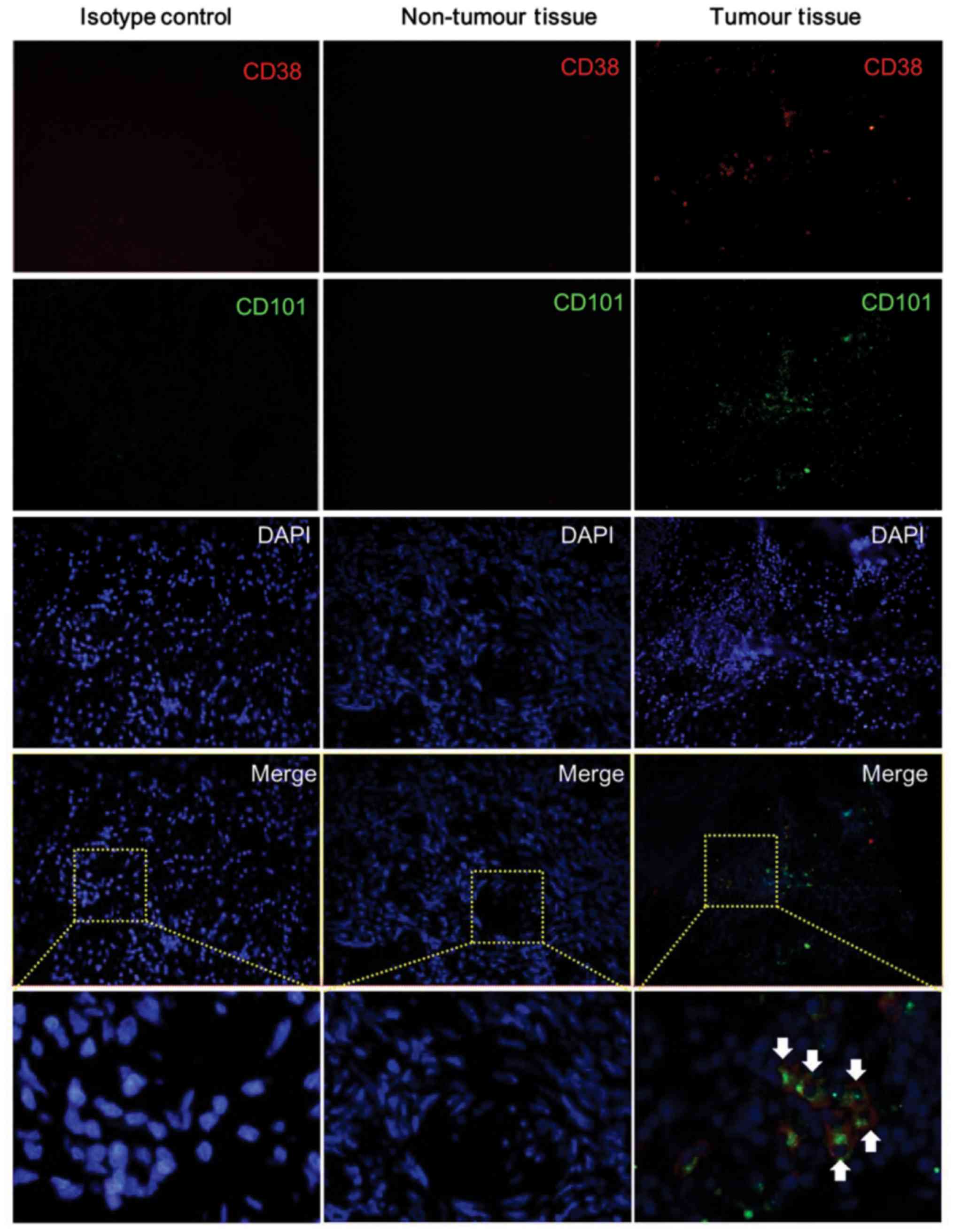|
1
|
Siegel RL, Miller KD and Jemal A: Cancer
statistics, 2017. CA Cancer J Clin. 67:7–30. 2017. View Article : Google Scholar : PubMed/NCBI
|
|
2
|
Miller EM, Tymon-Rosario J, Strickler HD,
Xie X, Xue X, Kuo DYS, Makhija SK and Nevadunsky NS: Racial
differences in survival from epithelial ovarian cancer are
associated with stage at diagnosis and use of neoadjuvant therapy:
A 10-year single-institution experience with a racially diverse
urban population. Int J Gynecol Cancer. 28:749–756. 2018.
View Article : Google Scholar : PubMed/NCBI
|
|
3
|
Dong X, Men X, Zhang W and Lei P: Advances
in tumor markers of ovarian cancer for early diagnosis. Indian J
Cancer. 51 (Suppl 3):e72–e76. 2014. View Article : Google Scholar : PubMed/NCBI
|
|
4
|
Santoiemma PP and Powell DJ Jr: Tumor
infiltrating lymphocytes in ovarian cancer. Cancer Biol Ther.
16:807–820. 2015. View Article : Google Scholar : PubMed/NCBI
|
|
5
|
Prosser ME, Brown CE, Shami AF, Forman SJ
and Jensen MC: Tumor PD-L1 co-stimulates primary human CD8(+)
cytotoxic T cells modified to express a PD1:CD28 chimeric receptor.
Mol Immunol. 51:263–272. 2012. View Article : Google Scholar : PubMed/NCBI
|
|
6
|
Festino L, Botti G, Lorigan P, Masucci GV,
Hipp JD, Horak CE, Melero I and Ascierto PA: Cancer treatment with
anti-PD-1/PD-L1 agents: Is PD-L1 expression a biomarker for patient
selection? Drugs. 76:925–945. 2016. View Article : Google Scholar : PubMed/NCBI
|
|
7
|
Schietinger A, Philip M, Krisnawan VE,
Chiu EY, Delrow JJ, Basom RS, Lauer P, Brockstedt DG, Knoblaugh SE,
Hämmerling GJ, et al: Tumor-specific T cell dysfunction is a
dynamic antigen-driven differentiation program initiated early
during tumorigenesis. Immunity. 45:389–401. 2016. View Article : Google Scholar : PubMed/NCBI
|
|
8
|
Philip M, Fairchild L, Sun L, Horste EL,
Camara S, Shakiba M, Scott AC, Viale A, Lauer P, Merghoub T, et al:
Chromatin states define tumour-specific T cell dysfunction and
reprogramming. Nature. 545:452–456. 2017. View Article : Google Scholar : PubMed/NCBI
|
|
9
|
Rådestad E, Klynning C, Stikvoort A,
Mogensen O, Nava S, Magalhaes I and Uhlin M: Immune profiling and
identification of prognostic immune-related risk factors in human
ovarian cancer. Oncoimmunology. 8:e15357302018. View Article : Google Scholar : PubMed/NCBI
|
|
10
|
Ochsenbein AF, Klenerman P, Karrer U,
Ludewig B, Pericin M, Hengartner H and Zinkernagel RM: Immune
surveillance against a solid tumor fails because of immunological
ignorance. Proc Natl Acad Sci USA. 96:2233–2238. 1999. View Article : Google Scholar : PubMed/NCBI
|
|
11
|
Ada G: The enunciation and impact of
Macfarlane Burnet's clonal selection theory of acquired immunity.
Immunol Cell Biol. 86:116–118. 2008. View Article : Google Scholar : PubMed/NCBI
|
|
12
|
Reimann J, Böhm W and Schirmbeck R:
Alternative processing pathways for MHC class I-restricted epitope
presentation to CD8+ cytotoxic T lymphocytes. Biol Chem Hoppe
Seyler. 375:731–736. 1994.PubMed/NCBI
|
|
13
|
Wei F, Zhong S, Ma Z, Kong H, Medvec A,
Ahmed R, Freeman GJ, Krogsgaard M and Riley JL: Strength of PD-1
signaling differentially affects T-cell effector functions. Proc
Natl Acad Sci USA. 110:E2480–E2489. 2013. View Article : Google Scholar : PubMed/NCBI
|
|
14
|
Arasanz H, Gato-Cañas M, Zuazo M,
Ibañez-Vea M, Breckpot K, Kochan G and Escors D: PD1 signal
transduction pathways in T cells. Oncotarget. 8:51936–51945. 2017.
View Article : Google Scholar : PubMed/NCBI
|
|
15
|
Srinivasan P, Wu X, Basu M, Rossi C and
Sandler AD: PD-L1 checkpoint inhibition and anti-CTLA-4 whole tumor
cell vaccination counter adaptive immune resistance: A mouse
neuroblastoma model that mimics human disease. PLoS Med.
15:e10024972018. View Article : Google Scholar : PubMed/NCBI
|
|
16
|
Ishida Y, Agata Y, Shibahara K and Honjo
T: Induced expression of PD-1, a novel member of the immunoglobulin
gene superfamily, upon programmed cell death. EMBO J. 11:3887–3895.
1992. View Article : Google Scholar : PubMed/NCBI
|
|
17
|
Freeman GJ, Long AJ, Iwai Y, Bourque K,
Chernova T, Nishimura H, Fitz LJ, Malenkovich N, Okazaki T, Byrne
MC, et al: Engagement of the PD-1 immunoinhibitory receptor by a
novel B7 family member leads to negative regulation of lymphocyte
activation. J Exp Med. 192:1027–1034. 2000. View Article : Google Scholar : PubMed/NCBI
|
|
18
|
Dong H, Zhu G, Tamada K and Chen L: B7-H1,
a third member of the B7 family, co-stimulates T-cell proliferation
and interleukin-10 secretion. Nat Med. 5:1365–1369. 1999.
View Article : Google Scholar : PubMed/NCBI
|
|
19
|
Wang C, Thudium KB, Han M, Wang XT, Huang
H, Feingersh D, Garcia C, Wu Y, Kuhne M, Srinivasan M, et al: In
vitro characterization of the anti-PD-1 antibody nivolumab,
BMS-936558, and in vivo toxicology in non-human primates. Cancer
Immunol Res. 2:846–856. 2014. View Article : Google Scholar : PubMed/NCBI
|
|
20
|
Xu-Monette ZY, Zhang M, Li J and Young KH:
PD-1/PD-L1 blockade: Have we found the key to unleash the antitumor
immune response? Front Immunol. 8:15972017. View Article : Google Scholar : PubMed/NCBI
|
|
21
|
Hellström I, Hellström KE, Pierce GE and
Yang JP: Cellular and humoral immunity to different types of human
neoplasms. Nature. 220:1352–1354. 1968. View Article : Google Scholar : PubMed/NCBI
|
|
22
|
Brahmer J, Reckamp KL, Baas P, Crinò L,
Eberhardt WE, Poddubskaya E, Antonia S, Pluzanski A, Vokes EE,
Holgado E, et al: Nivolumab versus docetaxel in advanced
squamous-cell non-small-cell lung cancer. N Engl J Med.
373:123–135. 2015. View Article : Google Scholar : PubMed/NCBI
|
|
23
|
Robert C, Long GV, Brady B, Dutriaux C,
Maio M, Mortier L, Hassel JC, Rutkowski P, McNeil C,
Kalinka-Warzocha E, et al: Nivolumab in previously untreated
melanoma without BRAF mutation. N Engl J Med. 372:320–330. 2015.
View Article : Google Scholar : PubMed/NCBI
|
|
24
|
Quarona V, Zaccarello G, Chillemi A,
Brunetti E, Singh VK, Ferrero E, Funaro A, Horenstein AL and
Malavasi F: CD38 and CD157: A long journey from activation markers
to multifunctional molecules. Cytometry B Clin Cytom. 84:207–217.
2013. View Article : Google Scholar : PubMed/NCBI
|
|
25
|
d'Ettorre G, Ceccarelli G, Serafino S,
Giustini N, Cavallari EN, Bianchi L, Pavone P, Bellelli V,
Turriziani O, Antonelli G, et al: Dominant enrichment of
phenotypically activated CD38(+) HLA-DR(+) CD8(+) T cells, rather
than CD38(+) HLA-DR(+) CD4(+) T cells, in HIV/HCV coinfected
patients on antiretroviral therapy. J Med Virol. 88:1347–1356.
2016. View Article : Google Scholar : PubMed/NCBI
|
|
26
|
Mao X, Peng L, Liu X, Yang Y, Wang Q, Wang
D, Xiao J and Leng J: TLR9 expression is positively correlated with
the levels of CD38, HLA-DR and CD95 on peripheral blood mononuclear
cells in chronic HBV infected patients. Xi Bao Yu Fen Zi Mian Yi
Xue Za Zhi. 32:660–665. 2016.(In Chinese). PubMed/NCBI
|
|
27
|
Rivas A, Ruegg CL, Zeitung J, Laus R,
Warnke R, Benike C and Engleman EG: V7, a novel leukocyte surface
protein that participates in T cell activation. I. Tissue
distribution and functional studies. J Immunol. 154:4423–4433.
1995.PubMed/NCBI
|
|
28
|
Soares LR, Tsavaler L, Rivas A and
Engleman EG: V7 (CD101) ligation inhibits TCR/CD3-induced IL-2
production by blocking Ca2+ flux and nuclear factor of
activated T cell nuclear translocation. J Immunol. 161:209–217.
1998.PubMed/NCBI
|
|
29
|
Gouttefangeas C, Jacquot S, Meffre E,
Schmid M, Boumsell L and Bensussan A: Differential proliferative
responses in subsets of human CD28+ cells delineated by BB27 mAb.
Int Immunol. 6:423–430. 1994. View Article : Google Scholar : PubMed/NCBI
|
|
30
|
Urban N, Mcintosh MW, Andersen M and
Karlan BY: Ovarian cancer screening. Hematol Oncol Clin North Am.
17989–1005. (ix)2003. View Article : Google Scholar : PubMed/NCBI
|
|
31
|
Urban N and Drescher C: Current and future
developments in screening for ovarian cancer. Womens Health (Lond).
2:733–742. 2006.PubMed/NCBI
|
|
32
|
Kafali H, Artunc H and Erdem M: Evaluation
of factors that may be responsible for cyclic change of CA125
levels during menstrual cycle. Arch Gynecol Obstet. 275:175–177.
2007. View Article : Google Scholar : PubMed/NCBI
|
|
33
|
Bast RC Jr, Badgwell D, Lu Z, Marquez R,
Rosen D, Liu J, Baggerly KA, Atkinson EN, Skates S, Zhang Z, et al:
New tumor markers: CA125 and beyond. Int J Gynecol Cancer. 15
(Suppl 3):S274–S281. 2005. View Article : Google Scholar
|
|
34
|
Rosen DG, Wang L, Atkinson JN, Yu Y, Lu
KH, Diamandis EP, Hellstrom I, Mok SC, Liu J and Bast RC Jr:
Potential markers that complement expression of CA125 in epithelial
ovarian cancer. Gynecol Oncol. 99:267–277. 2005. View Article : Google Scholar : PubMed/NCBI
|
|
35
|
Zhao T and Hu W: CA125 and HE4:
Measurement tools for ovarian cancer. Gynecol Obstet Invest.
81:430–435. 2016. View Article : Google Scholar : PubMed/NCBI
|
|
36
|
Xi QP, Pu DH and Lu WN: Research on
application value of combined detection of serum CA125, HE4 and TK1
in the diagnosis of ovarian cancer. Eur Rev Med Pharmacol Sci.
21:4536–4541. 2017.PubMed/NCBI
|
|
37
|
Zhang M, Yang J, Zhou J, Gao W, Zhang Y,
Lin Y, Wang H, Ruan Z and Ni B: Prognostic values of
CD38+CD101+PD1+CD8+ T
cells in pancreatic cancer. Immunol Invest. 48:466–479. 2019.
View Article : Google Scholar : PubMed/NCBI
|
|
38
|
Kumari S: Serum biomarker based algorithms
in diagnosis of ovarian cancer: A review. Indian J Clin Biochem.
33:382–386. 2018. View Article : Google Scholar : PubMed/NCBI
|
|
39
|
Hu ZD, Wei TT, Yang M, Ma N, Tang QQ, Qin
BD, Fu HT and Zhong RQ: Diagnostic value of osteopontin in ovarian
cancer: A meta-analysis and systematic review. PLoS One.
10:e01264442015. View Article : Google Scholar : PubMed/NCBI
|
|
40
|
Wei R, Wong JPC and Kwok HF: Osteopontin-a
promising biomarker for cancer therapy. J Cancer. 8:2173–2183.
2017. View Article : Google Scholar : PubMed/NCBI
|
|
41
|
Han X, Wang W, He J, Jiang L and Li X:
Osteopontin as a biomarker for osteosarcoma therapy and prognosis.
Oncol Lett. 17:2592–2598. 2019.PubMed/NCBI
|


















